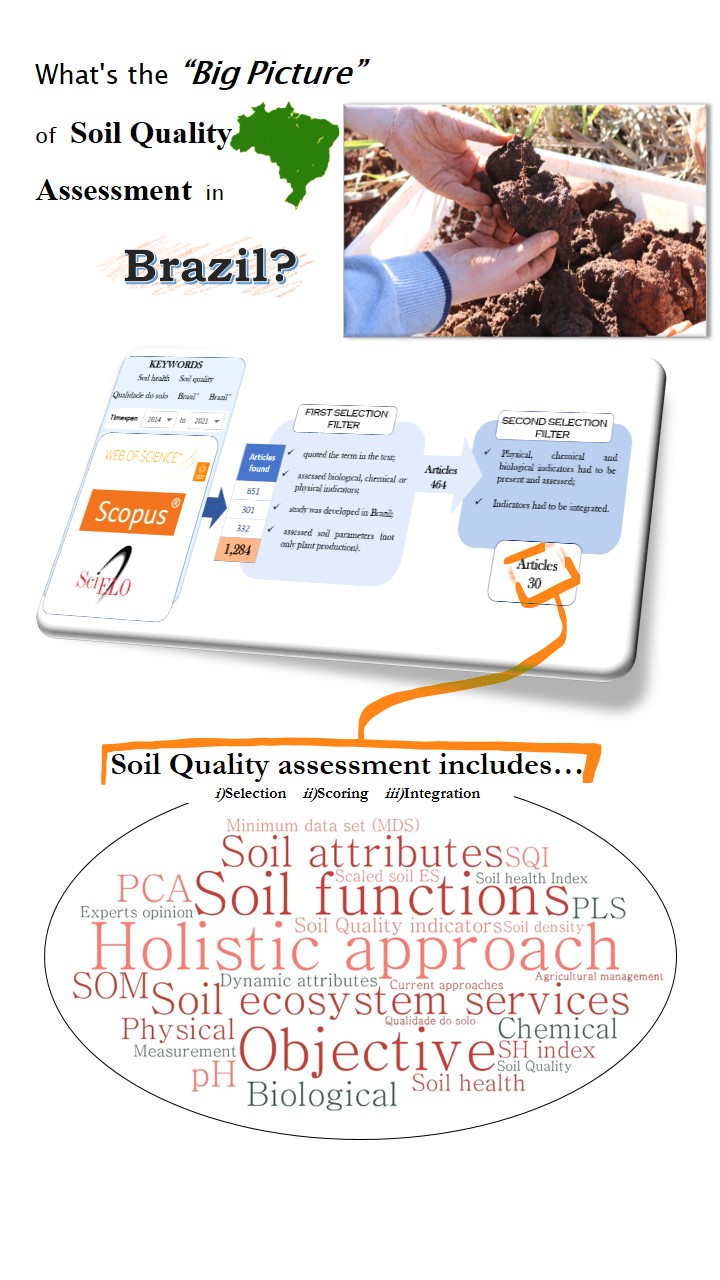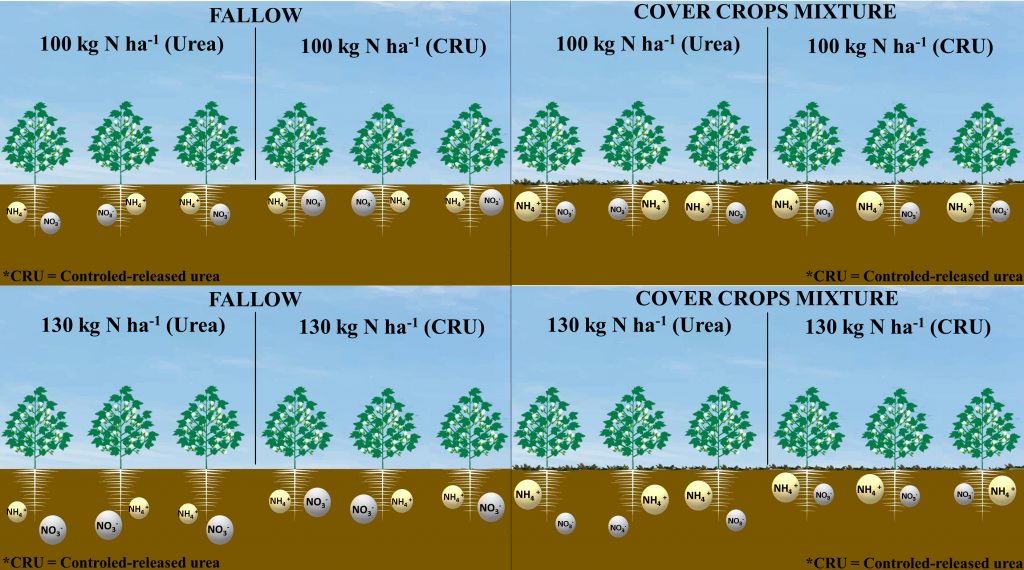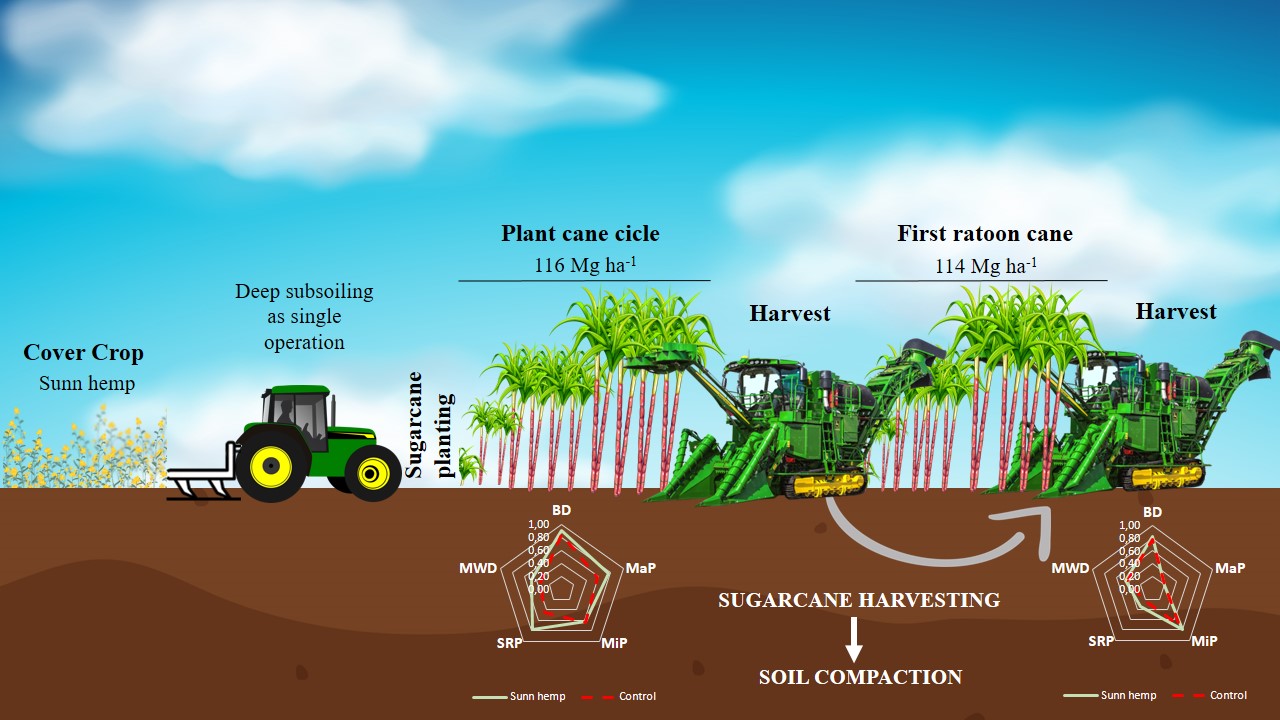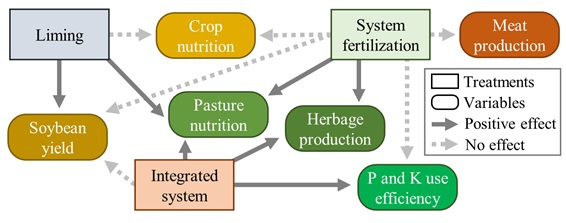Volume 46, 2022
Soil quality literature in Brazil: A systematic review
06/Apr/2022
ABSTRACT Brazilian soil scientists have increased the use of the term “soil quality” in their scientific publications in the last decade. However, it remains unclear if those publications only mention “soil quality” in a broad context, or the studies are focused on soil quality assessments, integrating soil chemical, physical and biological indicators. The objective of this systematic review was to carry out a critical analysis of the conception in using the term “soil quality” in recent publications derived from studies […]
Adoption of the no-tillage system in Paraná State: A (re)view
13/Jan/2022
ABSTRACT The concept of a no-tillage system (NTS), or “Sistema Plantio Direto,” was established in Brazil from the evolution of no-tillage (NT) or “Plantio Direto,” given the edaphoclimatic conditions and the need to promote chemical, physical and biological improvements in cultivated soils. While “Plantio Direto” is a conservationist practice, “Sistema Plantio Direto” presents itself as an agricultural production system based on the simultaneous adoption of minimum soil disturbance, maintenance of permanent soil cover and crop rotation. This study reviews the […]
Cover crops and controlled-release urea decrease nitrogen mobility and improve nitrogen stock in a tropical sandy soil with cotton cultivation
02/Feb/2022
ABSTRACT Sandy soil often has low nitrogen (N) stock. Thus, crops grown in sandy soil rely on high levels of N fertilization. The use of cover crops and efficient fertilizers can increase N stock in the soil and N availability in the topsoil, and reduce overall fertilizer costs. The objective of this study was to evaluate the effects of cover crops (fallow, a single grass species (ruzigrass), two grass species (ruzigrass + millet), one grass species (millet) with legumes [lime-yellow […]
Rainfall erosivity estimation: Comparison and statistical assessment among methods using data from Southeastern Brazil
02/Feb/2022
ABSTRACT Rainfall erosivity (R factor) is one of the six factors of the Universal Soil Loss Equation, being calculated based on the product of rainfall kinetic energy multiplied by its 30-minute maximum intensity. However, the lack of detailed and reliable rainfall data in many parts of the world has driven the use of other methods to estimate rainfall erosivity based on daily, monthly or annual data. These methods still need to be assessed to determine if their estimates are consistent […]
Soil physical change and sugarcane stalk yield induced by cover crop and soil tillage
28/Jan/2022
ABSTRACT Conventional tillage and intensive machinery traffic are the major causes of physical soil degradation in sugarcane fields. This study evaluates the impact of adopting conservation management practices during sugarcane planting on soil physical properties and stalk yield of sugarcane in the municipality of Ibitinga, state of São Paulo, Brazil. The experimental design (split-block) included four cover crops and three soil tillage systems, with three repetitions. For comparison purposes, a control treatment was also included (without cover crop and under […]
Urban soils in Brazil: A review
14/Mar/2022
ABSTRACT This study analyzes the scientific production about soils within cities in Brazil, the most populous country of Latin America, to highlight significant patterns and contributions and point out gaps and future challenges. A more robust literature about urban soils in Brazil started in the 90´s decade and has intensified since 2015. Papers are mostly published in Portuguese, majority performed in cities with more than 500,000 inhabitants, many of them located in the Southern and Southeastern regions, and mainly focused […]
Fertilization strategies and liming in no-till integrated crop–livestock systems: effects on phosphorus and potassium use efficiency
31/May/2022
ABSTRACT In an integrated crop-livestock system (ICLS), system fertilization exploits the nutrient cycling imposed by animal grazing and increases the system efficiency. An increasingly popular approach to fertilization in southern Brazil is anticipating P and K requirements for soybeans into the pasture phase. This can increase the use efficiency of these nutrients in ICLS based on meat production in winter and soybean in summer. This study aimed to evaluate the effect of fertilization strategy, grazing and soil acidity correction on […]
Effects of Meloidogyne incognita on the fungal community in tobacco rhizosphere
04/Mar/2022
ABSTRACT The often widespread and serious Root-Knot Nematode (RKN) disease is an important soil-borne disease affecting tobacco production. This study aimed to understand micro-ecological changes caused by RKN disease and interactions between disease and rhizosphere soil fungal communities. The 18S rRNA gene sequencing was used to study changes in rhizosphere fungal community of tobacco plants having RKN disease. In June 2018, a paired comparison was performed between rhizosphere fungal community structures of healthy tobacco plants and those with RKN disease […]
CO2 emission affected by moisture content and aggregate sizes in a calcareous soil of Comarca Lagunera, Mexico
14/Mar/2022
ABSTRACT Soil CO2 emissions are formed from biotic and abiotic processes related to organic carbon (SOC) and inorganic carbon (SIC), respectively. Calcareous soil has a high amount of SIC and occurs mainly in arid areas, and little is known about CO2 emissions from aggregates of this soil. This study aims to evaluate the emission of CO2 of aggregates from calcareous soil in the Comarca Lagunera, Mexico. Soil samples were taken from the layers of 0.00-0.15 and 0.15-0.30 m, and soil […]
Soil macrofauna, mesofauna and microfauna and their relationship with soil quality in agricultural areas in northern Colombia: ecological implications
11/Jul/2022
ABSTRACT Soil fauna is an essential component of the soil ecosystem for maintaining nutrient cycling and biological soil fertility. This study assessed the soil biodiversity (macrofauna, mesofauna, and microfauna) to define strategies for the sustainable management of tropical agricultural soils. The study was carried out in 200 agricultural production units in the Department of Sucre, in northern Colombia. Physicochemical properties (organic matter, nitrogen, phosphorus, and pH) were determined for each soil sample. The Berlesse-Tullgren method was used to determine the […]








